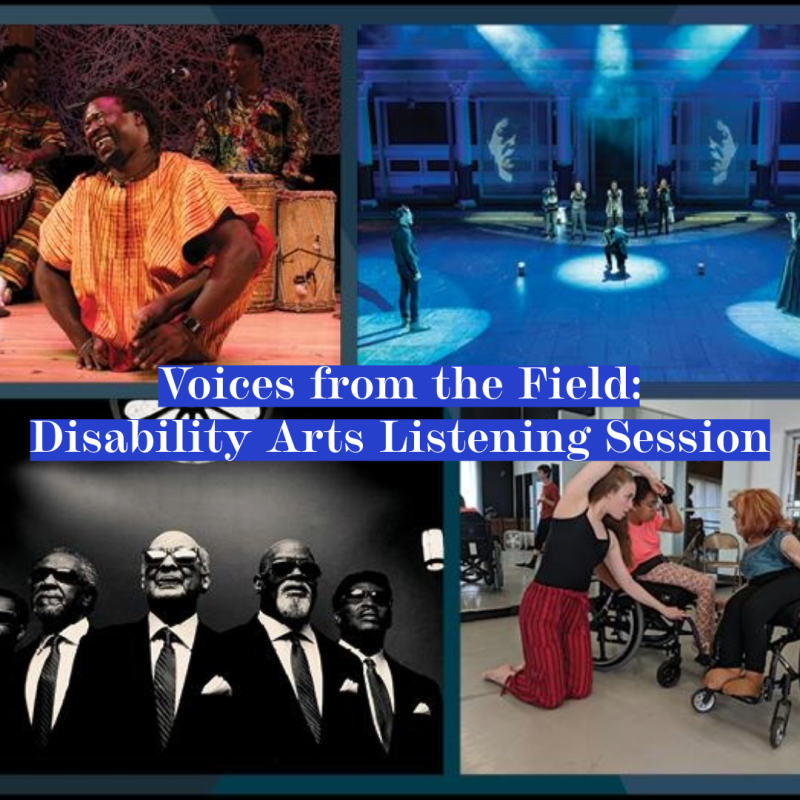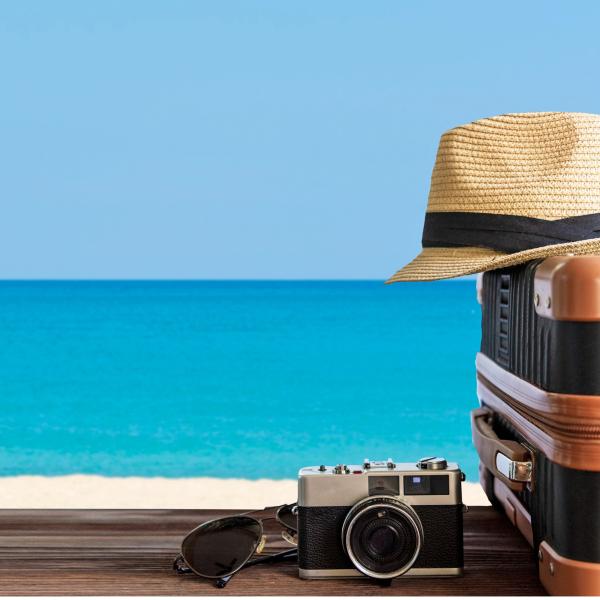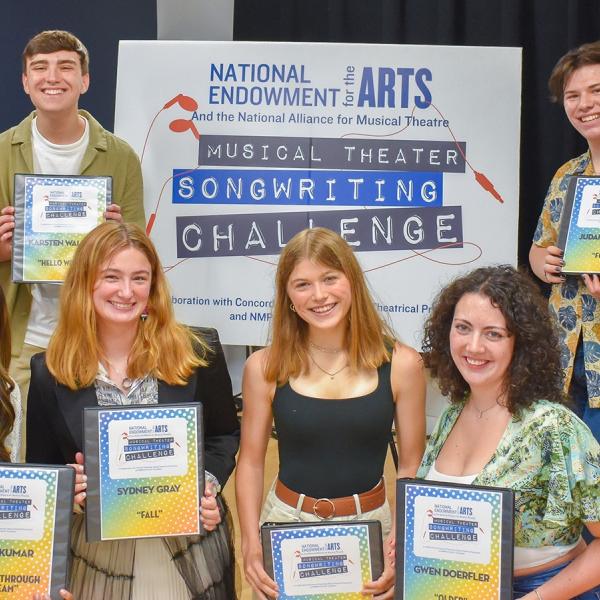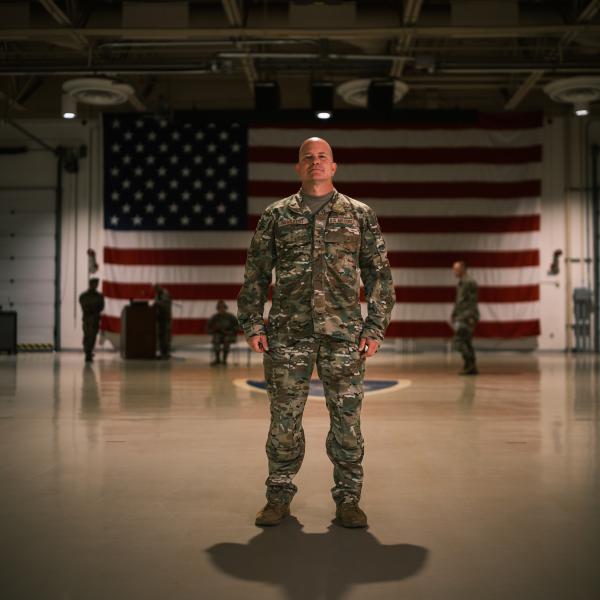Voices from the Field: How Can the Arts Sector Make a Better Environment for Disabled Artists? (Part Three: a “Blue Sky” Vision)

How can the arts sector support the best environment for all artists to work and flourish? On September 30, 2024, the NEA Office of Accessibility held a listening session to find out what disabled artists need to do their work in a healthy, safe, and productive environment. In the first two blogs in this series, we reported on the findings from this rich discussion, including the barriers to working in the arts and what is needed to create the best environment for disabled artists to do their work. In this final blog of the series, we’ll address the ideal, “blue sky” vision of an arts sector that enables all artists, especially those with disabilities, to create, learn, and present their work.
This topic has been on our minds lately because we’ve seen several great examples of arts organizations creating the best environment for their artists through open communication and a willingness to integrate access services throughout the timeline of a project. The first is the production of How to Dance in Ohio, a musical featuring a cast of young autistic adults that ran on Broadway in late 2025 and early 2024. At the start of the production, the producers surveyed all cast and crew to ask what they needed to do their work effectively. They followed up by incorporating the requests into the production. Examples of access provided included quiet spaces, the flexibility to take needed breaks during rehearsals with no questions asked, and the tailoring of costumes and lighting to accommodate sensory needs.
In an example from film, in the recent adaptation of the musical Wicked, actress Marissa Bode, a wheelchair user, was cast as Nessarose and has spoken about the access accommodations she was provided throughout the production process. Working with a disability consultant hired for the film, the production provided the accommodations she requested, including ramps throughout the set as well as a customized trailer with a chair lift, voice-activated doors, and a makeup station and kitchen built to accommodate a wheelchair. She has noted the safety she felt throughout the filming process, as the director and producers checked in with her regularly about her access needs.
Both examples showed how open communication and prioritizing input from disabled actors can create a safe and effective working environment.
These examples demonstrate accessibility in action, but what does it look and feel like across genres and different disability experiences? This blog focuses on what participants in our listening session said arts organizations and employers can do to be more accessible and responsive to disabled artists, further engaging and building community.
Accessible work environments
While accessibility requirements under the Rehabilitation Act of 1973 and the Americans with Disabilities Act of 1990 have been around for decades, many artists still encounter inaccessible arts spaces and limited access to programs and communication. When invited to imagine the ideal vision of the arts, commenters remained largely focused on asking for the bare minimum they are entitled to with existing access and anti-discrimination laws. As one speaker reflected, “I just want the laws that have been in place for decades to be followed…If we can just get to the floor so we can see the sky, that would be great.”
Much of this comes down to funding for program accessibility (e.g., sign language, captions, audio description), and funding for construction and architectural modifications to artist and audience spaces. While the cost of access accommodations can be built into many grant budgets, participants suggested that funders also add accessibility for programs and facilities as criteria for their grants. As one participant said, “funding the accessibility and making it happen creates community. When you create a community, it creates a place where everyone thrives.”
Disabled artists bring attention to ways all artists can better perform. Many accommodations are cost-free or very inexpensive to provide. Flexibility in scheduling, considering what it takes for a disabled artist to get to a location and the breaks they may need to take to ensure their needs are met, was mentioned by several of the respondents as a means of access. Rigorous rehearsal schedules and timelines can be taxing to the body and the mind. One commenter said that it’s important that artists are, “…noticing our bodies and getting grounded in our bodies. Not going past where we can go without agreement.” While we know that certain activities must be kept on track and on schedule, such as performances and exhibit openings, but it does not have to be all-or-nothing. Organizations can allow room for flexibility in their approach, including allowing breaks and the option to step aside to take care of one’s access needs (such as medication, stretching, quiet spaces, or rest), which can help all artists continue their work safely and effectively.
Cost-free options also include auto captions for meetings and virtual events, implementing a fragrance-free policy, or changing the lighting in the room. In addition to accessibility, participants urged arts organizations to think about new approaches to how things are done. In relation to acting, specifically, one respondent called for “blind casting” to open pathways for expanded diversity in representation, rather than limiting roles based on appearance or specific traits.
Expanded Leadership Opportunities
Some of the disconnect between what access is needed and what is provided can be explained by the lack of disabled artists in leadership roles. People with disabilities should have opportunities to work in all roles in the arts, at all levels of employment, including leadership and decision-making positions. One participant noted that access decisions are often left up to non-disabled people who have less understanding of the lives and access needs of people with disabilities. As a commenter said, “I think getting more disabled people into every layer of leadership within the arts, from the highest levels all the way through [would help]. We need more people who are disabled and [part of] the decision-making process. In those leadership roles, we can meet needs and not [be] working from the bottom of the barrel.”
Some respondents noted that many current arts employment and funding opportunities are not fully inclusive, especially for those who are multiply marginalized. One commenter dreamt of a “blue sky” which called for, “acceptance of those who are disabled and in recovery, in poverty, or experiencing incarceration via prison or hospital into the larger disability community. This includes access to grants, job opportunities, and opportunities to learn or sell art given at the same rate as anyone else.”
Raise Asset Limits
A persisting barrier for artists is the fear of losing disability benefits because of asset restrictions. Multiple participants called for raising or eliminating asset limits that prevent those receiving benefits from accepting grant funding or otherwise earning income in arts-based careers. An illustration of an alternate approach was offered by a disabled artist who shared the advantage of veterans’ benefits, which aren’t tied to how much money you make or where the income comes from: “My blue sky would be that SSI benefits work more like VA benefits.” Removing restrictions or at least raising asset limits is a vision for the future that continues to be advanced within the disability community.
Building community
Participants also voiced the need for community and connection and noted that accessibility is central to creating community. As one participant said about the fully accessible arts center they worked in, “It allowed me to have a place outside of my home to create and connect with others. I connected with other artists and other resources… When you create a community, it creates a place where everyone thrives.” It is also important to remember the work it can take to get to a physical space, including transportation. Participants discussed the need for hybrid options and the need to make them accessible to help create space for community, “There will still be situations where people cannot physically be there, so how do we find the technology of spaces to make them more accessible for hybrid events?” Community extends across disability and geography. In talking about community, one participant reminded all to consider their rural communities, “My blue-sky vision entails having rural communities be serviced just as much as the urban counterparts.” Disabled artists appreciated the listening session as a time to come together and even asked to keep in touch after the session, demonstrating the major impact providing space for connections can have.
Community helps foster safety. Being in an arts environment with disabled artists and other people with disabilities creates a safe environment to explore and to express themselves. People need to feel safe to disclose disability in the workplace or request an accommodation in an arts environment, and awareness and education around disability and access can help the wider arts sector expand that zone of safety. Creating and supporting networks of disabled artists, whether virtual or in person, local or spread across the country, can enable artists to share, learn, and grow together.
More Widely Available Information and Educational Resources
Several commenters mentioned the need for continued accessibility education for arts organizations and arts employers. This was particularly important for smaller entities, community groups, and grassroots organizations that may lack capacity for bigger learning initiatives. Hiring an accessibility consultant or forming an access advisory committee with paid members is a way to gain guidance around policies (i.e. COVID protocols and emergency procedures) and to build accessibility into programming. Another suggestion for educating people about accessibility was giving awards or accolades for staff and organizations that implement accessibility and meaningfully practice inclusion.
This listening session provided us with a rich source of input from the disability community about their needs and vision for their work. Our goal is to use this information to continue educating arts organizations, arts employers, and funders about not only the tremendous talent and creativity of disabled artists, but also how they can ensure they have the tools and environment to do their work in the most healthy, safe, and productive environment.
We’d like to thank the participants of the listening session and everyone who provided written comments. We also thank Emily Ladau for her assistance in synthesizing and highlighting themes from the discussion. For arts organizations seeking to learn more about providing access accommodations and disabled artists seeking information about how to pursue their career, we invite you to check out our Toolkit on Careers in the Arts for People with Disabilities, featuring information for artists, arts employers, arts educators, and funders, as well as additional NEA Accessibility resources.
Beth Bienvenu is the director of the Office of Accessibility at the National Endowment for the Arts, and Katharine Hayward is the NEA’s Accessibility Specialist. Beth and Katharine manage the NEA's technical assistance and advocacy work devoted to making the arts accessible for people with disabilities, older adults, veterans, and people in institutional settings.





